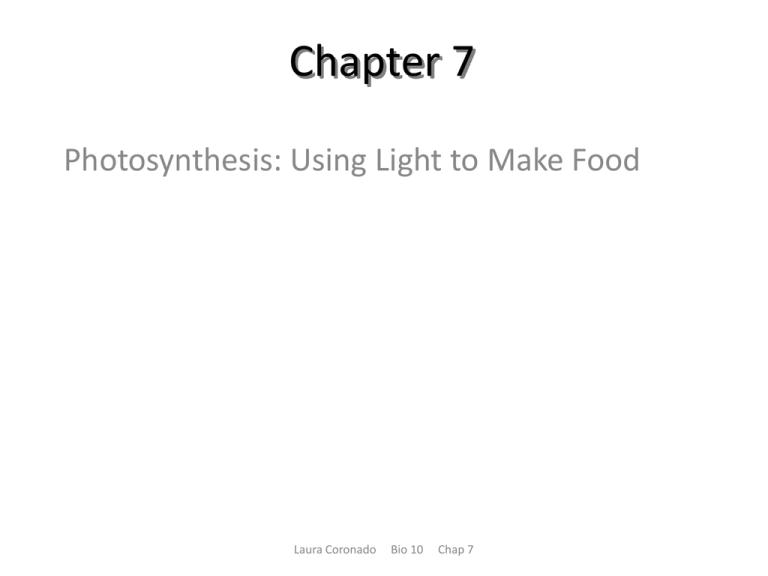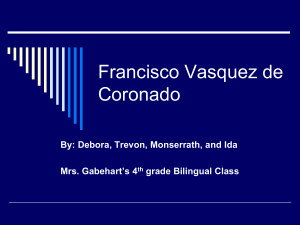Chapter 7
advertisement

Chapter 7 Photosynthesis: Using Light to Make Food Laura Coronado Bio 10 Chap 7 Biology and Society: Green Energy – Wood has historically been the main fuel used to: • Cook • Warm homes • Provide light at night – Industrialized societies replaced wood with fossil fuels. – To limit the damaging effects of fossil fuels, researchers are investigating the use of biomass (living material) as efficient and renewable energy sources. Laura Coronado Bio 10 Chap 7 Laura Coronado Bio 10 Chap 7 Figure 7.0 Biology and Society: Green Energy – Fast-growing trees, such as willows: • Can be cut every three years • Do not need to be replanted • Are a renewable energy source • Produce fewer sulfur compounds • Reduce erosion • Provide habitat for wildlife Laura Coronado Bio 10 Chap 7 THE BASICS OF PHOTOSYNTHESIS – Photosynthesis: • Is used by plants, some protists, and some bacteria • Transforms light energy into chemical energy • Uses carbon dioxide and water as starting materials – The chemical energy produced via photosynthesis is stored in the bonds of sugar molecules. – Organisms that use photosynthesis are: • Photosynthetic autotrophs • The producers for most ecosystems Laura Coronado Bio 10 Chap 7 PHOTOSYNTHETIC AUTOTROPHS Photosynthetic Protists (aquatic) Photosynthetic Bacteria (aquatic) LM Plants (mostly on land) Forest plants Kelp, a large alga Laura Coronado Micrograph of cyanobacteria Bio 10 Chap 7 Figure 7.1 Chloroplasts: Sites of Photosynthesis – Chloroplasts are: • The site of photosynthesis • Found mostly in the interior cells of leaves – Inside chloroplasts are membranous sacs called thylakoids, which are suspended in a thick fluid, called stroma. – Thylakoids are concentrated in stacks called grana. – The green color of chloroplasts is from chlorophyll, a light-absorbing pigment. – Stomata are tiny pores in leaves where carbon dioxide enters and oxygen exits. Laura Coronado Bio 10 Chap 7 Chloroplast Inner membrane Outer membrane Vein Granum O2 Leaf cross section Interior cell TEM Stomata Thylakoid LM CO2 Stroma Laura Coronado Bio 10 Chap 7 Figure 7.2-2 Light energy 6 CO2 6 H2O Carbon dioxide Water C6H12O6 Photosynthesis Laura Coronado Bio 10 Glucose Chap 7 6 O2 Oxygen gas Figure 7.UN1 Photosynthesis – Sunlight provides the energy – Electrons are boosted “uphill” and added to carbon dioxide – Sugar is produced – During photosynthesis, water is split into: • Hydrogen • Oxygen – Hydrogen is transferred along with electrons and added to carbon dioxide to produce sugar. – Oxygen escapes through stomata into the atmosphere. Laura Coronado Bio 10 Chap 7 A Photosynthesis Road Map – Photosynthesis occurs in two stages: • The light reactions convert solar energy to chemical energy • The Calvin cycle uses the products of the light reactions to make sugar from carbon dioxide Laura Coronado Bio 10 Chap 7 CO2 H2O Light Chloroplast NADP+ ADP P Calvin cycle Light reactions ATP NADPH Sugar O2 (C6H12O6) Laura Coronado Bio 10 Chap 7 Figure 7.3-2 THE LIGHT REACTIONS: CONVERTING SOLAR ENERGY TO CHEMICAL ENERGY – Chloroplasts: • Are chemical factories powered by the sun • Convert solar energy into chemical energy Laura Coronado Bio 10 Chap 7 The Nature of Sunlight – Sunlight is a type of energy called radiation, or electromagnetic energy. – The full range of radiation is called the electromagnetic spectrum. Laura Coronado Bio 10 Chap 7 Increasing wavelength 10–5 nm 10–3 nm Gamma rays X-rays 1 nm 103 nm 106 nm Microwaves Infrared UV 103 m 1m Radio waves Visible light 380 400 500 Wavelength (nm) 600 Wavelength = Laura Coronado Bio 10 580 nm Chap 7 Figure 7.4 700 750 The Process of Science: What Colors of Light Drive Photosynthesis? – Observation: In 1883, German biologist Theodor Engelmann saw that certain bacteria tend to cluster in areas with higher oxygen concentrations. – Question: Could this information determine which wavelengths of light work best for photosynthesis? – Hypothesis: Oxygen-seeking bacteria will congregate near regions of algae performing the most photosynthesis. Laura Coronado Bio 10 Chap 7 The Process of Science: What Colors of Light Drive Photosynthesis? – Experiment: Engelmann: • Laid a string of freshwater algal cells in a drop of water on a microscope slide • Added oxygen-sensitive bacteria to the drop • Used a prism to create a spectrum of light shining on the slide – Results: Bacteria: • Mostly congregated around algae exposed to red-orange and blue-violet light • Rarely moved to areas of green light – Conclusion: Chloroplasts absorb light mainly in the blue-violet and red-orange part of the spectrum. Laura Coronado Bio 10 Chap 7 Light Prism Microscope slide Number of bacteria Bacterium Algal cells 400 500 600 Wavelength of light (nm) Laura Coronado Bio 10 Chap 7 Figure 7.5 700 Light Reflected light Chloroplast Absorbed light Transmitted light Laura Coronado Bio 10 Chap 7 Figure 7.6 Chloroplast Pigments – Chloroplasts contain several pigments: • Chlorophyll a: – Absorbs mostly blue-violet and red light – Participates directly in the light reactions • Chlorophyll b: – Absorbs mostly blue and orange light – Participates indirectly in the light reactions Laura Coronado Bio 10 Chap 7 Carotenoids • Absorb mainly blue-green light • Participate indirectly in the light reactions • Absorb and dissipate excessive light energy that might damage chlorophyll • The spectacular colors of fall foliage are due partly to the yellow-orange light reflected from carotenoids. Laura Coronado Bio 10 Chap 7 Laura Coronado Bio 10 Chap 7 Figure 7.7 How Photosystems Harvest Light Energy – Light behaves as photons, discrete packets of energy. – A photosystem is a group of chlorophyll and other molecules that function as a lightgathering antenna. – Chlorophyll molecules absorb photons. • Electrons in the pigment gain energy. • As the electrons fall back to their ground state, energy is released as heat or light. Laura Coronado Bio 10 Chap 7 Excited state (a) Absorption of a photon e– Light Heat Light (fluorescence) Photon Chlorophyll molecule Ground state (b) Fluorescence of a glow stick Laura Coronado Bio 10 Chap 7 Figure 7.8 Chloroplast Pigment molecules Primary electron acceptor Photon Electron transfer Reactioncenter chlorophyll a Antenna pigment molecules Transfer of energy Photosystem Thylakoid membrane Laura Coronado Bio 10 Chap 7 Figure 7.9-3 Reaction center How the Light Reactions Generate ATP and NADPH – Two types of photosystems cooperate in the light reactions: • The water-splitting photosystem • The NADPH-producing photosystem – The light reactions are located in the thylakoid membrane. Laura Coronado Bio 10 Chap 7 Primary electron acceptor Primary electron acceptor Energy to make ATP 2e – 2e – NADPH 2e – Light Light Reactioncenter chlorophyll Reactioncenter chlorophyll H2O NADPH-producing photosystem 2e – 1 2 H+ + O2 2 NADP Water-splitting photosystem Laura Coronado Bio 10 Chap 7 Figure 7.10-3 – An electron transport chain: • Connects the two photosystems • Releases energy that the chloroplast uses to make ATP Laura Coronado Bio 10 Chap 7 To Calvin cycle Light Light H NADPH NADP H ATP ADP P Stroma Thylakoid membrane Photosystem Electron transport chain ATP synthase Photosystem Inside thylakoid Electron flow 2e – H2 O H H H H 1 O 2 2 Laura Coronado Bio 10 Chap 7 H Figure 7.11a e– ATP e– e– NADPH e– e– e– e– NADPH-producing photosystem Water-splitting photosystem Laura Coronado Bio 10 Chap 7 Figure 7.12 THE CALVIN CYCLE: MAKING SUGAR FROM CARBON DIOXIDE – The Calvin cycle: • Functions like a sugar factory within the stroma of a chloroplast • Regenerates the starting material with each turn Laura Coronado Bio 10 Chap 7 CO2 (from air) P Three-carbon molecule RuBP sugar P ADP P ATP P ADP P Calvin cycle NADPH ATP NADP G3P sugar G3P sugar P P G3P sugar Glucose (and other organic compounds) P Laura Coronado Bio 10 Chap 7 Figure 7.13-4 Evolution Connection: Solar-Driven Evolution – C3 plants: • Use CO2 directly from the air • Are very common and widely distributed – C4 plants: • Close their stomata to save water during hot and dry weather • Can still carry out photosynthesis – CAM plants: • Are adapted to very dry climates • Open their stomata only at night to conserve water Laura Coronado Bio 10 Chap 7 ALTERNATIVE PHOTOSYNTHETIC PATHWAYS C4 Pathway (example: sugarcane) Cell type 1 CAM Pathway (example: pineapple) CO2 Night CO2 Four-carbon compound Four-carbon compound Cell type 2 CO2 CO2 Calvin cycle Calvin cycle Sugar C4 plant Laura Coronado Day Sugar CAM plant Bio 10 Chap 7 Figure 7.14 Light energy 6 CO2 6 H2O Carbon dioxide Water C6H12O6 Photosynthesis Laura Coronado Bio 10 Glucose Chap 7 6 O2 Oxygen gas Figure 7.UN1 Light CO2 H2O Light reactions NADP ADP P Calvin cycle ATP NADPH Sugar (C6H12O6) O2 Laura Coronado Bio 10 Chap 7 Figure 7.UN2 Light CO2 H2O NADP ADP P Light reactions Calvin cycle ATP NADPH Sugar (C6H12O6) O2 Laura Coronado Bio 10 Chap 7 Figure 7.UN3 Chloroplast Light CO2 H2O Stack of thylakoids NADP+ Stroma ADP P Light reactions Calvin cycle ATP NADPH Sugar (C6H12O6) O2 Laura Coronado Bio 10 Chap 7 Figure 7.UN5 ADP e– acceptor ATP e– acceptor 2e – 2e – NADPH 2e – Photon Photon Chlorophyll H2O Chlorophyll NADPH-producing photosystem 2e – 2 H + + 1 O2 2 NADP+ Water-splitting photosystem Laura Coronado Bio 10 Chap 7 Figure 7.UN6 CO2 ADP ATP Calvin cycle NADPH P NADP G3P P Laura Coronado Bio 10 Chap 7 Glucose and other compounds Figure 7.UN7








